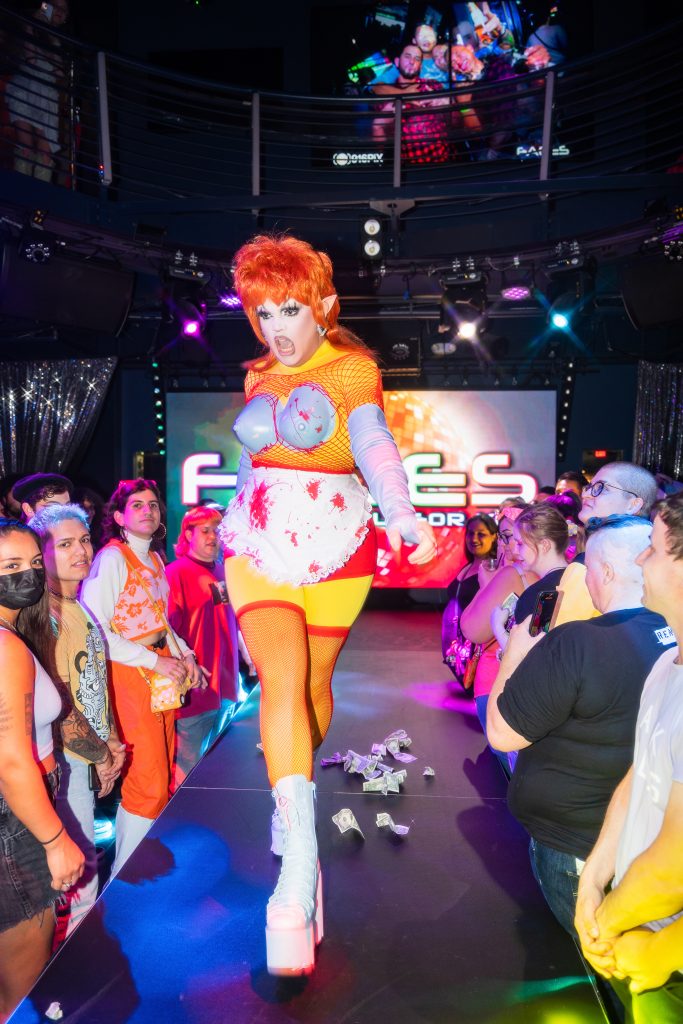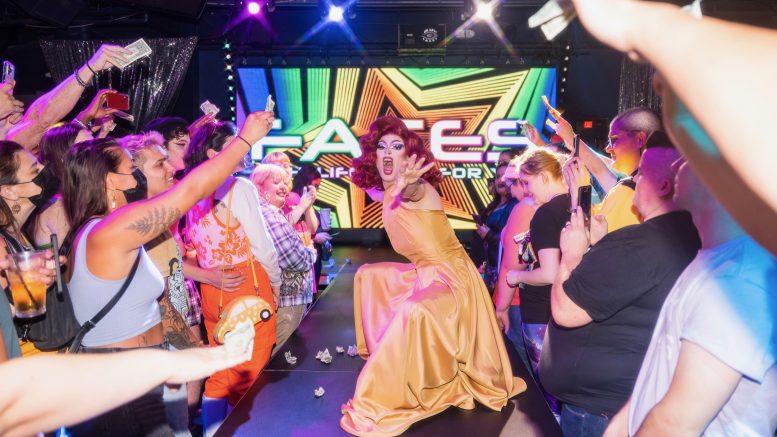By Chris Bogard
On a blistering summer day with temperatures hitting 106 degrees, drag queens fearlessly gathered to celebrate Pride on one of the biggest stages in California: the State Fair & Food Festival. In addition to a family friendly drag show, the annual celebration organized by Out at the Fair on July 15 included activities such as drag bingo, drag queen storytime and a fashion show.
Out at the Fair describes itself as an inclusive, community-focused celebration of LGBTQ+ pride and diversity held at various state and county fairs throughout the United States to promote equality and acceptance. During the family friendly drag show, queens leapt off stage, interacted with the large crowd, shared rainbow flags and selfies with fans, and even danced on tables while the audience of all ages cheered them on.
Local drag shows are no longer limited to LGBTQ+ spaces, as queens, kings and everyone in-between (and beyond) are being invited to host and perform at the straightest of places such as Crocker Art Museum and Punch Line Comedy Club. This is a new phenomenon that starkly contrasts with the anti-drag rhetoric taking place in some other states. While Florida, Texas and Tennessee attempt — and fail— to limit or ban drag, Sacramento is celebrating and investing in it as a source of entertainment, creative expression and revenue.
“There’s certainly a boom” happening in the realm of Sacramento drag, says A La Mode, a local host and performer. There are more shows popping up at new venues around town faster than you can say “Shante, You Stay.” From drag brunches at K Street’s newest venues Solomon’s Vinyl Diner and Roscoe’s Bar & Burgers, to long-standing dinner shows at Capitol Garage and The Flamingo House, there’s no shortage of drag festivities to choose from, especially in the downtown area.
Pushing the Boundaries of Drag Presentation

As trends and media content reach new heights in popularity and demand, they have a tendency to become stale and formulaic in order to maintain a level of profitability and consumability, and drag is no different.
A La Mode (she/her in drag, he/they/them out of drag), a local host and performer, agrees: “I feel like now especially we’re taught, or we’re supposed to, brand ourselves to always look the same. And sure, that’s recognizable to people, but it’s kind of boring. You know, I don’t think that being the Nike swoosh of drag is actually pushing the medium. … I think you’re ultimately conforming to a capitalist structure, like you’re presenting yourself in this ideal way or this highly curated way and nothing in life is that polished or that seamless.”
While television shows like “RuPaul’s Drag Race” and “We’re Here” continue to break down barriers and bring home Emmys, there’s a tinge of predictability and safety within what’s being represented in mainstream media. For a local drag scene, it’s important to embrace and celebrate alternative expressions of drag that aren’t often shown on TV, like those that expand beyond traditional gender presentation.
This is a sentiment expressed by drag artist Mudd (he/they in drag, all pronouns out of drag) who says, “A lot of times, I think it’s assumed that when you’re a drag king, you have to present with this more ‘masculine’ persona. But I think when it comes to what drag is, it’s more of an art form than it is a gender expression or gender enhancement, it’s just this play on what beauty is and what art is, and being able to do that with your body and your face and performance.”
Mudd describes themselves as a deaf, queer, multiracial, BIPOC, Latinx, 2-Spirit, sober drag king. “I’m able to connect very deeply with the disabled community, and with the Black, BIPOC, Native and Latinx community. I’m able to connect with all these different communities, because I’m all of these communities kind of wrapped up into one person. I think that’s what’s most important to me – connection.”
While many drag show lineups still showcase mostly feminine-presenting drag performers that align with what’s represented on TV, several local venues offer alternative shows to shine a spotlight on the lesser-seen talent in the area, including drag kings, genderqueer performers, drag monsters and more.

Azutanah (he/him in and out of drag), winner of the sixth season of local drag competition Maxx Drag Show definitely falls into the “other” category. “Not everybody wants to be mainstream,” Azutanah says. “Not everybody wants to be on TV. There’s other ways to conceptualize your success. … I have always visualized using this platform and using my skills for bigger ideas. I would like to be less of an entertainer and more of an artist, if that makes sense. But I think I’m always going to be open minded to the future possibilities.”
The Badlands-hosted drag competition series named after its host Clive Maxx is open to any style of drag performance rather than limiting its competitors to only drag queens. “Maxx Drag is its own thing, always has been, always will be. It’s run by a great team of people and it’s just really fun. Maxx Drag is totally open to anybody and super supportive of anybody,” says Azutanah, the competition’s reigning victor.
Maxx Drag Show’s fourth winner Mudd expressed their frustration with the lack of equity among drag shows and the performers they include, saying “Kings are not very welcomed and are not very encouraged. They do not have as many opportunities, they do not get the same kind of clout, they do not get the same kind of representation.”
Debbie Wu Chang and Daisha Alexander, co-founders of the monthly day party Queer City, aim to change that. A spotlight for underrepresented artists, diverse queer individuals and local vendors, Queer City is a POC/women/nonbinary/trans-led pop-up event held at Solomon’s Vinyl Diner that offers “a platform for performers of all gender expression,” according to co-founder Debbie Wu Chang (they/them).
“It is clear that there is a strong desire in Sacramento for drag kings and/or nonbinary/trans individuals to display their art. … There’s a lot of energy here,” Wu Chang says.
For drag king Mudd, they have had an overwhelmingly positive, albeit uncommon, experience. “I have had the absolute fortune of being very, very, very commended (as a king). … I have had opportunity after opportunity after opportunity presented to me and I keep saying yes, and it keeps getting more and more ridiculous and absurd. I have a lot of really, really lovely people that I am surrounded by that I get to celebrate my queerness with in this way. And if I have any opportunity to uplift any of my other fellow kings, I absolutely do.”
Drag Breaks Down Barriers — and Perceptions of It

Variety and diversity isn’t only important to who’s performing, but also where they’re performing: Drag is being featured in countless spaces that don’t fit the typical gay bar or nightclub expectation.
With that, the content of the performances can drastically change according to the audience, from a “drag queen story hour” where the host reads kid-friendly stories to children in modest costume, to ArtMix at the Crocker Art Museum where drag is showcased as a curated and creative artform to an audience that likely has never seen a drag performance before.
A La Mode returned for a second year to produce, curate, perform and host the 2023 Pride Month edition of Crocker Art Museum’s monthly themed event ArtMix: Camp, inspired by the infamous Met Gala theme.
“I think it’s really important to recognize drag as an art form alongside other mediums — photography, dance, theater, music, etc.” A La Mode says. “I think that because we are uniquely situated in nightlife and presented a lot in bars and nightclubs, there is a misconception about what we are presenting in our performance.”
With 1,300 people in attendance at the adult-only event, it was important for A La Mode to present drag in a different light than what may be expected. “It was an incredible energy that night, we had a really awesome cast. I walked away from that just feeling so grateful for the community that showed up for us at ArtMix.”
When it comes to the importance of expanding drag into non-queer spaces, A La Mode believes “people have one version of what they think drag is … and I think it’s important to kind of grow that perception. But more importantly, like now, more than ever, we need to take up space.” She adds, however, “I do think that drag does not belong in every space. And I think a challenge is that when you’re partnering with any venue, you want to make sure that they want you there for the right reasons.”

Similar complex views exist throughout the drag community, and according to Mudd, LGBTQ+ spaces are a safe haven and there’s a sanctity to drag that ought to be preserved.
“Part of me feels like it’s important [to expand drag into non-queer spaces] because having exposure to something different is not a bad thing,” Mudd says. “But the other part of me is like, keep our sacred spaces sacred, right? And this is like, in native terms, this is medicine. And not everybody needs this medicine, and not everybody gets this medicine.”
As the drag scene in Sacramento continues to thrive with high demand and even higher supply, there are certain things local performers would like to see change in the future. For A La Mode, the first thing that they hope for is more equity.
“We are long past the need for shows that only have queens booked in them,” A La Mode says. “We need more shows that reflect a truly diverse drag community, which is what we have here. And I also think a focus on fair pay, and actually sustainable working conditions.”
As Azutanah sees it, if current trends continue, the future of drag in Sacramento will “just be even more ubiquitous than it is now, and even more accepted than it is now. I think it’ll just be seen as a true staple, like something that’s kind of on everybody’s radar. And, hopefully, this is just the beginning. I mean, who knows what could happen? I want people to keep an open imagination.”
This story was done in collaboration with Sacramento City College’s journalism department.


Be the first to comment on " A Sacramento motto: ‘Drag isn’t here, it’s everywhere’"